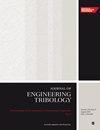Development and characterization of eco-friendly extruded green composites using PLA/wood dust fillers
IF 1.6
3区 工程技术
Q3 ENGINEERING, MECHANICAL
Proceedings of the Institution of Mechanical Engineers, Part J: Journal of Engineering Tribology
Pub Date : 2024-02-21
DOI:10.1177/13506501241233628
引用次数: 0
Abstract
Nowadays, there is a rising demand for bio-composite materials driven by the increasing need for sustainable alternatives and a desire to lessen dependence on conventional materials. These bio-composites resent eco-friendly solutions to address these challenges. In line with this, the present study focuses on the bio composite material which developed from polylactic acid (PLA) and wood dust (NF). Wood dust sourced from teak wood plants was employed as fillers. PLA served as the matrix material, supplemented with the plasticizer polyethylene glycol (PEG) to enhance PLA processing. The PLA/NF filament was produced through the extrusion process, and specimens were prepared using 3D printing techniques in accordance with ASTM standards. Various properties including mechanical, physical, thermal stability, and tribological properties were examined. Morphological structures were observed using scanning electron microscopy (SEM). The test results demonstrated improvements in enhanced mechanical robustness and tribological performance of the PLA composite. The tensile strength of the PLA/wood composite was enhanced by 11%. The hardness value of the PLA/wood composite increased by 27% with the addition of wood as filler material. However, the introduction of wood as filler material led to degradation in physical properties. The water absorption test revealed a thickness change of approximately 14% for the PLA wood composite, whereas for pure PLA, it was 9%. Thermal stability tests showed that the temperature resistance of PLA improved to 250 °C with the introduction of wood fillers. Biodegradability tests indicated that PLA wood composite has the potential to address environmental concerns associated with conventional materials.利用聚乳酸/木粉填料开发环保型挤压绿色复合材料并确定其特性
如今,人们对生物复合材料的需求日益增长,这是因为人们越来越需要可持续的替代品,并希望减少对传统材料的依赖。这些生物复合材料是应对这些挑战的生态友好型解决方案。有鉴于此,本研究重点关注由聚乳酸(PLA)和木屑(NF)制成的生物复合材料。木屑取自柚木植物,用作填料。聚乳酸作为基体材料,辅以增塑剂聚乙二醇(PEG)以增强聚乳酸的加工性能。聚乳酸/NF 长丝是通过挤压工艺制成的,试样是根据 ASTM 标准使用 3D 打印技术制备的。对各种性能进行了检测,包括机械、物理、热稳定性和摩擦学性能。使用扫描电子显微镜(SEM)观察了形态结构。测试结果表明,聚乳酸复合材料的机械坚固性和摩擦学性能均有所提高。聚乳酸/木材复合材料的拉伸强度提高了 11%。添加木材作为填充材料后,聚乳酸/木材复合材料的硬度值提高了 27%。然而,引入木材作为填充材料会导致物理性能下降。吸水率测试显示,聚乳酸木材复合材料的厚度变化约为 14%,而纯聚乳酸的厚度变化仅为 9%。热稳定性测试表明,引入木材填料后,聚乳酸的耐温性能提高到 250 °C。生物降解性测试表明,聚乳酸木材复合材料具有解决与传统材料相关的环境问题的潜力。
本文章由计算机程序翻译,如有差异,请以英文原文为准。
求助全文
约1分钟内获得全文
求助全文
来源期刊

CiteScore
4.20
自引率
5.00%
发文量
110
审稿时长
6.1 months
期刊介绍:
The Journal of Engineering Tribology publishes high-quality, peer-reviewed papers from academia and industry worldwide on the engineering science associated with tribology and its applications.
"I am proud to say that I have been part of the tribology research community for almost 20 years. That community has always seemed to me to be highly active, progressive, and closely knit. The conferences are well attended and are characterised by a warmth and friendliness that transcends national boundaries. I see Part J as being an important part of that community, giving us an outlet to publish and promote our scholarly activities. I very much look forward to my term of office as editor of your Journal. I hope you will continue to submit papers, help out with reviewing, and most importantly to read and talk about the work you will find there." Professor Rob Dwyer-Joyce, Sheffield University, UK
This journal is a member of the Committee on Publication Ethics (COPE).
 求助内容:
求助内容: 应助结果提醒方式:
应助结果提醒方式:


